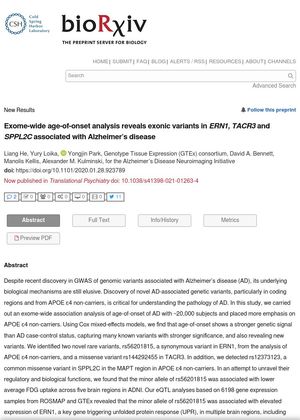Exome-Wide Age-of-Onset Analysis Reveals Exonic Variants in ERN1, TACR3, and SPPL2C Associated with Alzheimer’s Disease
January 2020
in “
bioRxiv (Cold Spring Harbor Laboratory)
”

TLDR Certain genetic variants in ERN1, TACR3, and SPPL2C are linked to when Alzheimer's disease starts.
In 2020, a study was conducted involving approximately 20,000 subjects to understand the genetic variants associated with Alzheimer's disease (AD), particularly in non-carriers of the APOE ε4 gene. The study found that age-of-onset of AD showed a stronger genetic signal than AD case-control status. Two novel rare variants were identified: rs56201815 in ERN1 and rs144292455 in TACR3. Additionally, a common missense variant in SPPL2C in the MAPT region, rs12373123, was detected in APOE ε4 non-carriers. The minor allele of rs56201815 was associated with lower average FDG uptake across five brain regions and elevated expression of ERN1, a key gene triggering unfolded protein response (UPR), in multiple brain regions. The protective minor allele of rs12373123 significantly increased expression of GRN in microglia and was associated with MAPT expression in astrocytes. These findings suggested the potential involvement of the UPR to ER stress in the pathological pathway of AD and provided insights into the regulatory mechanisms behind the effects of rs12373123 in multiple degenerative diseases including AD and Parkinson’s disease.
